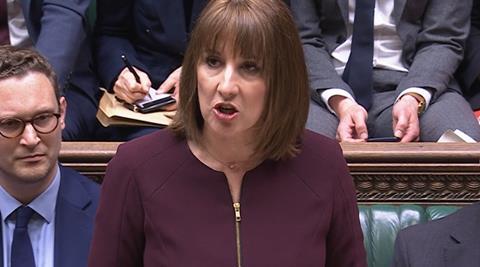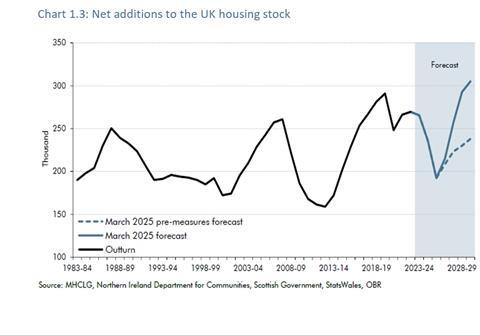Housebuilding to exceed 300,000 homes a year by 2029/30, excluding impact of forthcoming Affordable Homes Programme
The government’s changes to the National Planning Policy Framework (NPPF) will result in the construction of 1.3 million homes during the course of this parliament, the Office for Budget Responsibility (OBR) has said.

In a forecast published today alongside Rachel Reeves’ spring statement, the OBR said last year’s changes to the NPPF alone would add an extra 170,000 homes by 2029, pushing housebuilding to its highest level for 40 years. Completions are forecast to reach 305,000 homes a year by 2029-30.
It said: “This increased housebuilding over the forecast period is driven mainly by requirements for local authorities to release land to meet development needs as well as the strengthened presumption in favour of sustainable development which, if triggered, requires local authorities to release land for further development unless the adverse impacts of doing so significantly outweigh the benefits.”
It said most of the increase will take place from 2027/28 as it takes time for developers to identify sites, local authorities to bring forward local plans, capacity constraints in the sector to be overcome, and additional houses to be built.
Responding to the OBR, The Treasury pointed out new homes delivered under the next Affordable Homes Programme (AHP) and the Planning and Infrastructure Bill are not included in the forecast and ”will all help to reach” its manifesto target of building 1.5m homes by the end of the parliament.
The NPPF changes announced last year include the return of mandatory local housing targets and a new method to calculate them, along with measures aimed at relasing more green belt land for development.
Reeves announced today the government will invest a further £13bn in capital infrastructure over the next five years.
This figure includes housing expenditure along with infrastructure and defence. More information about the funding for housing, including the details of the next AHP, are expected to be announced in the spending review in June.
The chancellor committed to spending £2bn on infrastructure each year over the course of this Parliament above the £100bn promised in last year’s autumn Budget.
An extra £2.2bn will also be handed to the Ministry of Defence next year as part of plans to bring defence spending up to 2.5% of GDP by 2027.
Sparing construction from a raft of spending cuts Reeves said she was boosting capital investment in public sector projects to “drive forward the economy”.

“I am not cutting capital spending as the party opposite did time and time again, because that choked off growth and it left our school roofs literally crumbling. That was the wrong choice, it was the irresponsible choice, it was the Tory choice,” the chancellor said.
It comes as part of a package of measures aiming to balance the books after £10bn of fiscal headroom at the time of the autumn budget was wiped out by an increase in the cost of servicing government debt.
Reeves said cuts to welfare payments announced today would save £4.8bn, while a crackdown on tax avoidance and evasion would add £1bn to Treasury coffers.
While the Office for Budget Responsibility (OBR) has halved its growth forecast for 2025 from 2% to 1%, it said the chancellor’s measures would put the government on course to restore its £10bn fiscal headroom by the end of the Parliament.










No comments yet